
Increasingly complex cloud security threats and risks have led to a rise in cloud security tooling in recent years. However, increased tooling has also led to increased costs and manpower, leading many organizations to shift toward tool consolidation. In this article, we will dive into the rise of cloud-native application protection platforms (CNAPPs), the role they play in tool consolidation, and key features to consider when choosing a CNAPP.
What is a Cloud-Native Application Protection Platform (CNAPP)?
Cloud-Native Application Protection Platforms (CNAPPs) are a unified approach to protecting cloud-native infrastructure and applications that consolidate multiple individual solutions under a single umbrella. CNAPPs do a lot, integrating both proactive and reactive security capabilities to protect cloud-native infrastructure and applications, including:
Identity Management
Identity management makes sure the right individuals have appropriate access to resources, balancing security and usability. In cloud environments, standalone tools like Cloud Infrastructure Entitlement Management (CIEM) manage and monitor permissions to reduce overprivilege across complex, multi-cloud setups.
Threat Detection and Response
Threat detection and response focuses on identifying and mitigating security risks in real time to protect systems from active threats. In cloud environments, Cloud Detection and Response (CDR) specializes in uncovering and addressing threats specific to cloud workloads, while Digital Forensics and Incident Response (DFIR) encompasses both detection and response from an evidentiary standpoint.
Cloud Security Posture Management
Cloud security posture management ensures that cloud environments are configured securely by continuously monitoring for misconfigurations and compliance violations. CSPM offers visibility, and is augmented by tools such as cloud workload protection platforms (CWPP) which monitor workloads, bringing visibility to tasks running in a cloud environment, including those running on virtual machines, serverless functions, or containers.
Risk Detection and Prioritization
Risk detection and prioritization involve identifying cloud vulnerabilities and prioritizing vulnerabilities that pose the most critical risks. The approach reduces noise from volumes of vulnerabilities that aren’t internet-facing or have no known exploits, for example.
Discovery and Protection of APIs
Discovery and protection of APIs are a key component of cloud workload security so teams ensure that APIs, including shadow APIs, are safeguarded against threats like unauthorized access. Under the shared responsibility model, organizations must secure their APIs while cloud providers manage the underlying infrastructure.
CNAPP Brings it Together
As a comprehensive cloud security platform, CNAPP integrates numerous capabilities that were previously found in cloud security posture management (CSPM), cloud detection and response (CDR), cloud workload protection (CWPP), vulnerability management, identity security (CIEM), and API security tools.
CNAPP platforms provide ongoing security monitoring throughout the development lifecycle for cloud-native technologies like APIs, microservices, containers, and service meshes.
With a CNAPP solution, security teams prioritize risk management, full visibility across a cloud ecosystem, and collaboration between development, security, and operations teams (DevSecOps), with automatic policy enforcement and scanning built for the cloud.
The TL;DR on CNAPP
Want the actual TL;DR on CNAPP (hint – it starts with runtime security)? Don’t spend days reading someone’s PhD dissertation – check out our comprehensive 8 step CNAPP guide.
Get The E-BookThe History of CNAPP
CNAPPs emerged from the need to address growing security risks in dynamic cloud environments. Early cloud security solutions focused on enforcing security policies for single cloud platforms, leaving gaps in visibility and control when workloads were deployed across multiple cloud environments.
Fragmented tools helped control security across platforms, but they did little to reduce the number of platforms that teams had to learn and use to control multiple aspects of the environment. As organizations adopted more complex architectures, CNAPPs emerged to unify tools like CSPM, CWPP, and CIEM, helping tame the tool sprawl. CNAPP became a way to secure applications and infrastructure in multi-cloud ecosystems, from a single place and with comprehensive visibility.
CNAPP Benefits for Cloud Security Challenges
CNAPP dominates conversations about cybersecurity as a powerhouse that takes runtime security seriously while remaining true to its promise to offer protection at the production stage.
The CNAPP market is expected to more than double in the coming years, growing from $7.8 billion in 2022 to $19.3 billion by 2027. That could be due to an appetite for consolidating the cloud security functions of CSPM and CWPP solutions, estimated to increase from 25% in 2022 of enterprises to 60%.
The popularity stems from what CNAPP does well. The key benefits of CNAPP benefits stem from the imperative to combine functions from app development through deployment. Here are the perks of such an approach:
CNAPP tames the chaos with a holistic strategy
By unifying diverse security tools such as CSPM, CWPP, and CIEM into a single platform, companies benefit from an integrated security approach that reduces security silos and offers seamless visibility and controls across workloads, containers, and serverless functions.
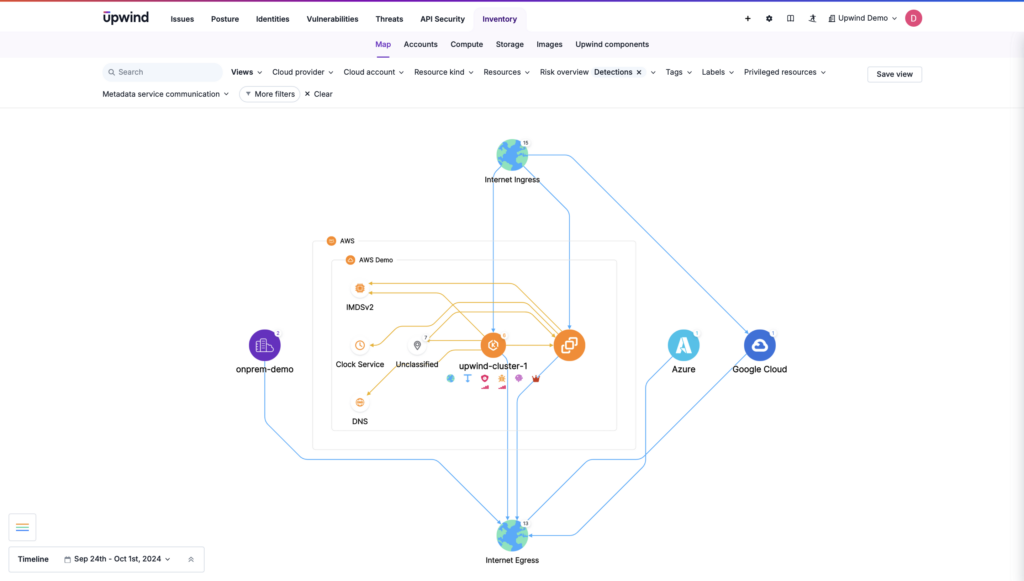
By integrating these tools, cybersecurity teams can:
- Streamline monitoring, configuration, and updating of their security infrastructure
- Troubleshoot issues with less manual effort
- Allocate resources more effectively
CNAPP highlights critical threats to reduce breach risk
Monitoring across cloud environments and the development lifecycle helps to reduce false positives and makes identifying true threats easier to identify and remediate.
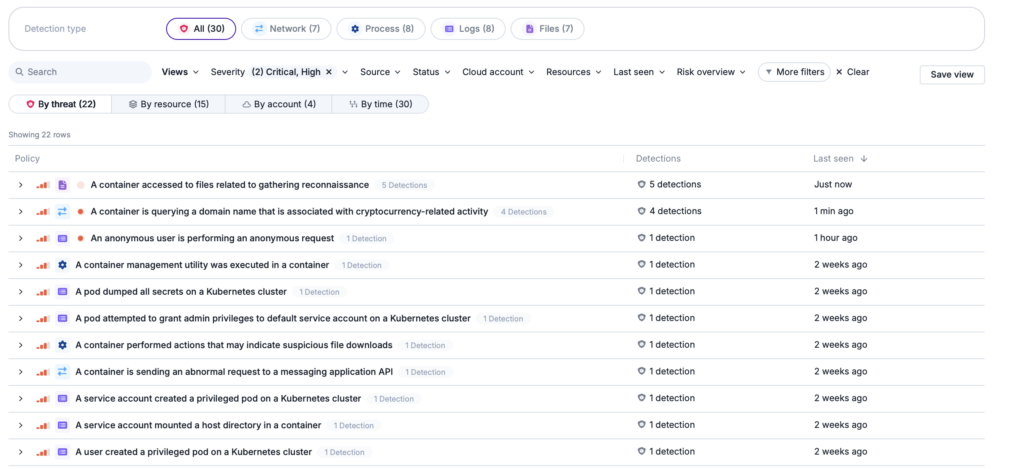
Behavior analysis is not exclusive to CNAPP, but CNAPPs offer significant advantages by integrating data from multiple components and contextualizing threats using more data for more accurate filtering. What’s happening right now in your environment? That’s an important part of how the most advanced CNAPPs can focus on the most significant threats, so you’re not swimming in non-critical alerts.
CNAPP consolidates tools for cost efficiency
Consolidating tools means fewer moving parts and lower costs. Not only does CNAPP reduce “tool creep,” but the holistic approach also streamlines security operations.
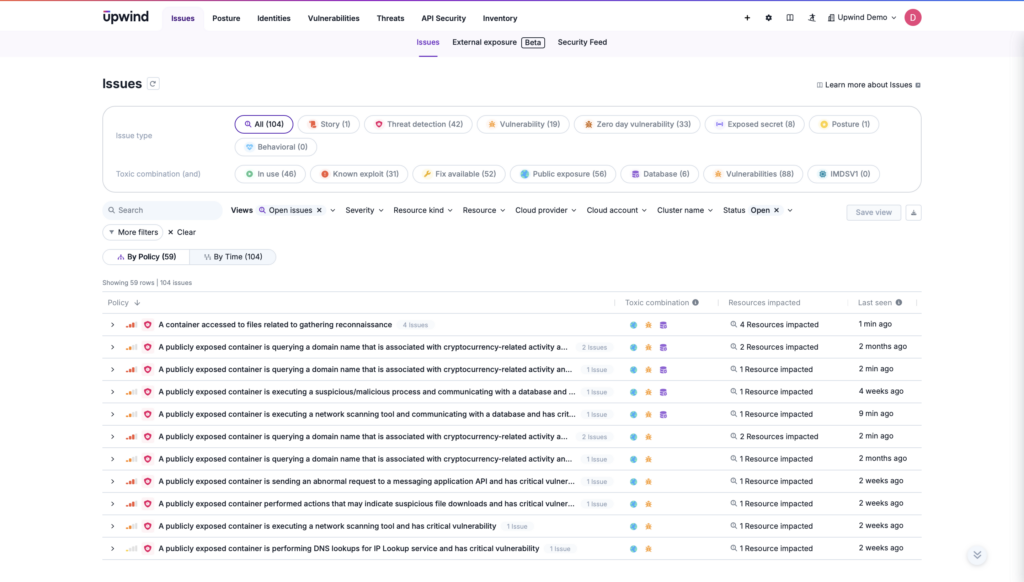
Cost savings are quantifiable in terms of software spend and daily operational costs, but related cost efficiencies also favor CNAPP solutions:
- Improved collaboration, so DevOps and security teams gain a common platform to manage security throughout the CI/CD pipeline.
- Streamlined compliance unifies controls and reporting for streamlined compliance management.
- Contextualizing alerts allows teams to prioritize critical risks and threats based on real environmental variables.
CNAPP accelerates the development and deployment cycle
Through integration with development tools and automated security checks, CNAPP makes it possible to correlate runtime misconfigurations and vulnerabilities with CI/CD context, helping teams fix problems at the source and accelerate development timelines.
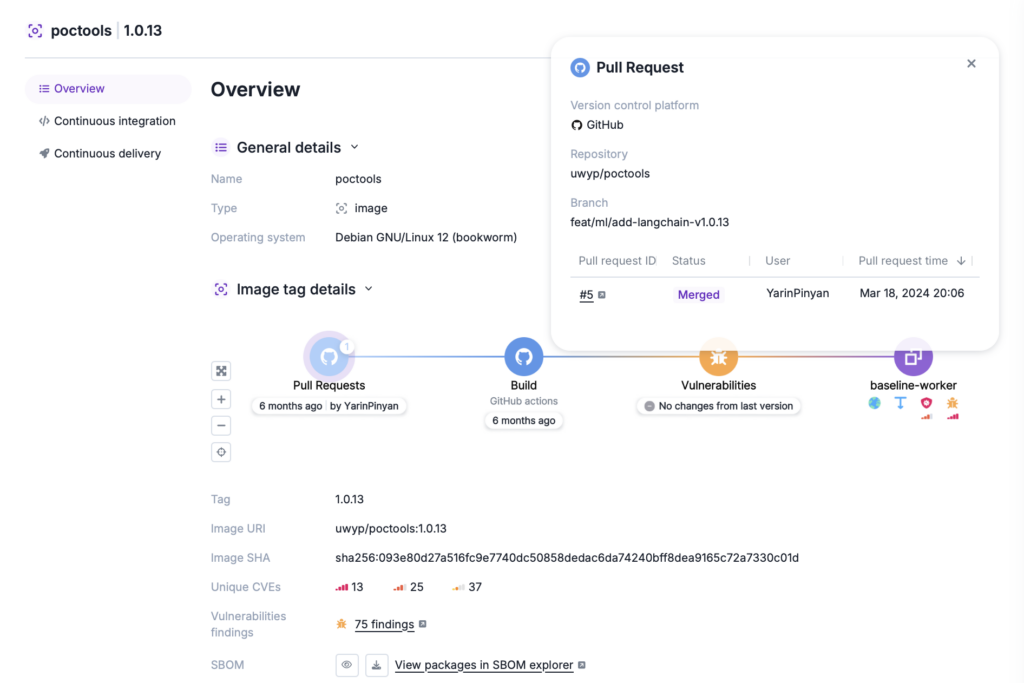
CNAPP’s DevSecOps approach means integration with CI/CD pipelines, as well as using machine learning and behavior analytics for threat detection and real-time detection of complex threats at runtime. Overall, the consolidated platform approach of a CNAPP reduces friction as teams can incorporate security requirements seamlessly into existing workflows.
How Do CNAPP Tools Work to Secure the Cloud Environment?
According to Gartner, CNAPP protects cloud-native applications across their lifecycle, encompassing both applications and infrastructure. While many view CNAPP as a combination of Cloud Security Posture Management (CSPM) and Cloud Workload Protection Platforms (CWPP), it provides additional essential functionalities.
Cloud Security Posture Management (CSPM)
The CSPM component is crucial for identifying and remediating misconfigurations and compliance issues within cloud infrastructures. It handles:
- Misconfiguration and unencrypted storage detection
- Policy enforcement
- Compliance monitoring
- Drift detection
Cloud Workload Protection Platform (CWPP)
The CWPP features protect cloud workloads by scanning for vulnerabilities and malware. Core features include:
- Container security
- Serverless security
- Virtual machine (VM) protection
- Workload isolation and segmentation
While the hybrid CSPM and CWPP definition captures essential aspects, modern CNAPPs extend their capabilities significantly to include:
- Cloud infrastructure entitlement management (CIEM): The CIEM governs identities, permissions, and access to provide more granular management of cloud environments.
- End-to-end visibility: By automating regulatory audits and reporting, comprehensive visibility helps to ensure compliance across various frameworks.
- DevSecOps integration: Workflows are structured to incorporate security practices into the development pipeline, fostering collaboration across the DevSecOps teams.
Advanced CNAPP platforms can also use machine learning to contextualize cloud activities, identify abnormal behavior, and prioritize threats based on risk levels. Additional capabilities may include:
- API security
- Infrastructure as code (IaC) scanning
- Kubernetes security posture management (KSPM)
- Cloud detection and response (CDR)
As CNAPPs evolve, they continue to incorporate new functionalities, becoming increasingly indispensable to the cloud security landscape, but also burdened with solving all things for all teams, even as use cases expand to multiple teams and priorities. The evolution mirrors that of EWP, CWPP, and CDR as they incorporated new functions, particularly related to cloud security.
CNAPP is not the only cloud security tool. How can you be sure it’s the right one for your overall security posture, given your cloud computing needs?
Runtime and Container Scanning with Upwind
Upwind offers runtime-powered container scanning features so you get real-time threat detection, contextualized analysis, remediation, and root cause analysis that’s 10X faster than traditional methods.
CNAPP vs Stand-Alone Security Tools
CNAPPs are all-in-one platforms that integrate security across the cloud environment. Because CNAPP grew out of CSPM and CWPP functions, some companies may opt to implement either of these solutions individually instead.
The “best-of-breed” approach to cloud-native security rejects the unified format of CNAPPs in favor of aligned individual tools.
For instance, best-of-breed security solutions may be specifically designed to address unique needs, such as a specific threat landscape or legacy system compatibility. They may be more streamlined and meet one team’s use cases better than a larger software product. While best-of-breed security can provide outstanding coverage in specialty areas, this approach can’t offer the same unified visibility of a CNAPP, and their patchwork of security functions may leave security gaps.
This table explains why a modern company might choose a CNAPP platform vs. a best-of-breed solution.
| Platform | CNAPP Use Case | Best-of-Breed Use Case |
|---|---|---|
| CNAPP (Cloud-Native Application Protection Platform) | Use CNAPP for comprehensive security across development, deployment, and runtime. | Best-of-breed isn’t applicable, as CNAPP itself is a unified approach. |
| CWPP (Cloud Workload Protection Platform) | Use CNAPP for broad workload security across the full lifecycle of cloud-native applications, combining infrastructure and workload protection. | Use a best-of-breed CWPP when there is a need for specialized workload protection (e.g., container or Kubernetes security) without requiring broader cloud infrastructure visibility. |
| CSPM (Cloud Security Posture Management) | Use CNAPP to provide both posture management and workload protection | Use a best-of-breed CSPM to focus on cloud configuration and compliance management without workload protection or other runtime capabilities. |
| CASB (Cloud Access Security Broker) | Use CNAPP to secure access at the infrastructure and workload levels, but with less focus on cloud SaaS app monitoring than CASB. | Use best-of-breed CASB for securing SaaS applications, data access control, and monitoring across 3rd-party cloud services. |
| DSPM (Data Security Posture Management) | Use CNAPP for some data security, but especially to secure workloads and applications. | Use best-of-breed DSPM for data governance and data security focused directly on identifying and protecting sensitive data across cloud storage and databases. |
| SIEM (Security Information and Event Management) | Use CNAPP for broad cloud-native security and real-time visibility across workloads and infrastructure without deep log management. | Use best-of-breed SIEM for centralized log management, advanced threat detection, and forensics. |
| CIEM (Cloud Infrastructure Entitlement Management) | Use CNAPP as part of a broad cloud-native security strategy with identity and access management to protect workloads and reduce risks from over-privileged access. | Use a best-of-breed CIEM for dedicated cloud identity governance and role management, especially for large, complex IAM environments in multi-cloud. |
| SASE (Secure Access Service Edge) | Use CNAPP for internal cloud-native security and workloads, not edge access. | Use Best-of-breed SASE to prioritize secure access to distributed resources that need network, edge, and remote user protection. |
| ASPM (Application Security Posture Management) | Use CNAPP for securing cloud-native applications and infrastructure in one platform during the development, deployment, and runtime stages. | Use best-of-breed ASPM for deep application security posture and vulnerability detection, including code repositories, libraries, and 3rd-party dependencies. |
CNAPP customers emerge victorious when CNAPP can address all use cases and users without bloat. That can be a challenge, as DevOps teams and compliance security operations analysts must be able to use CNAPP equally. After all, CNAPP doesn’t just consolidate tools, it consolidates teams. The best tools simplify the large number of functions and features of a CNAPP.
Common Pitfalls to Avoid
Despite their promise, many CNAPP platforms fall short in key areas. What should you look for when analyzing competing solutions?
- Fragmented Visibility: Many CNAPPs struggle to find a truly unified view, especially when it comes to hybrid, multi-cloud, and on-prem resources. Ask whether your solution can cover all your resources.
- Overwhelming noise in alerts: Misconfigurations are everywhere, and sometimes, knowing about them doesn’t help make your organization any safer. It’s about prioritizing the truly critical risks with built-in remediation workflows. Make sure your solution can filter out the noise so your team can focus on what really matters.
- Lack of context-aware security: Security and compliance challenges should be tied to real-world, cloud-native challenges that take your environment into account. Is your solution analyzing workloads dynamically, whether that’s pinpointing permission drift in Kubernetes clusters or securing serverless functions?
- Inadequate runtime protection: Some CNAPPs excel at scanning for misconfigurations, falling short in real-time runtime protection and leaving workloads exposed to active threats and vulnerabilities that only emerge at runtime. Monitor runtimes so vulnerabilities can be mitigated immediately, even in containerized, ephemeral environments.
The Future of CNAPP
As cloud environments continue to grow more complex and expand, scaling and spinning up workloads, CNAPPs are an ever more crucial part of securing the cloud. Organizations are deploying cloud resources across an increasing number of environments, including major cloud providers like Google Cloud, AWS, and Azure. As platforms retain their original mission to provide consistent, unified security across diverse infrastructure, they’ll need to evolve their security and compliance capabilities to account for the expanding environment (alongside an expanding threat landscape).
Where is it all leading? We have a few predictions:
We had a few questions for Chief Product Officer Joshua Burgin about where CNAPPs are headed in their next incarnations.
Q: Now that CNAPPs have brought together some of the biggest visibility and threat detection challenges under one roof, what are the next big challenges they’ll be called on to solve?
A: CNAPPs are getting more sophisticated, but so are attack tactics. AI is ubiquitous for attackers, not just software solutions…
Q: What future technologies do you see as central to CNAPP’s evolution in the near future?
A: Artificial intelligence, deeper integrations with cloud providers, more seamless alignment with zero-trust, etc.
Q: What’s the most intriguing possibility you see in the more distant future?
A: Risk prediction, proactive behavioral, and compliance alterations automatically to meet threats that haven’t even been dreamt up in their attackers’ heads yet.
Upwind Simplifies End-to-End Cloud Security
CNAPP is a first line of defense against security threats for organizations that used to split their attention between services, collate disorganized information, and find patterns in disparate reports, all the while wrestling with multiple tools.
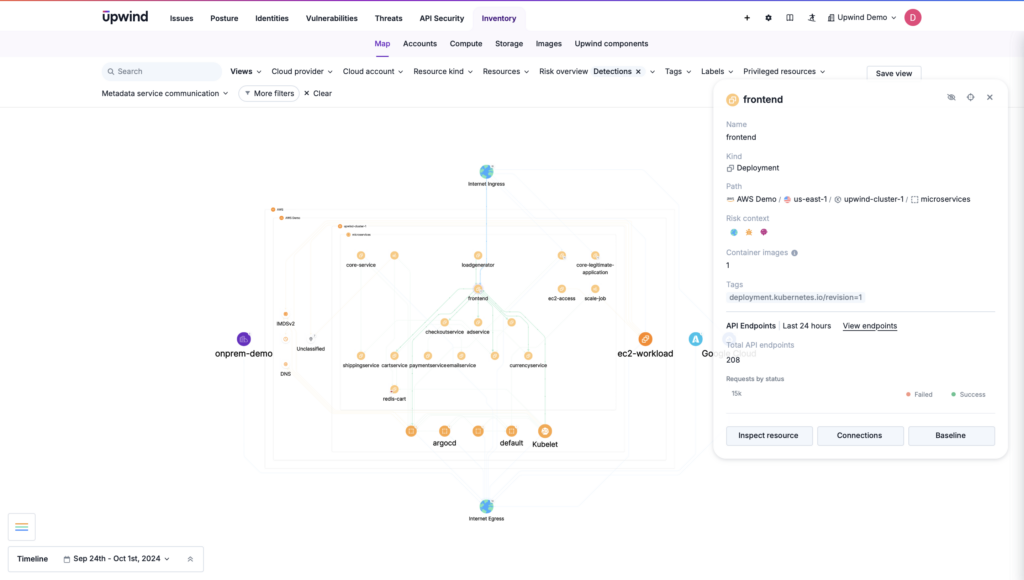
Upwind offers a unified CNAPP that protects cloud configurations, data, API, and identity security in one simple platform. Schedule a demo to see how.
FAQ
What about CNAP?
CNAP shares a similar acronym to CNAPP, but the two are distinct. CNAP refers to “Certified Network Associate Program,” a certification program in network security. It is designed for IT professionals or network administrators, not security or development teams.
What is the difference between CNAPP and SASE?
Secure Access Service Edge (SASE) and CNAPP are both platforms that help companies protect business functions and data in the cloud. However, SASE is a network security framework with the goal of securing access to the cloud and internal networks.
CNAPP, on the other hand, is focused on application and asset security in cloud environments and is designed for DevSecOps teams, not network and security teams.
Is CASB part of CNAPP?
No, a Cloud Access Security Broker (CASB) acts as an intermediary for accessing cloud services and does not assess the security applications developed, deployed, and running in the cloud. CASB shares some functions with CNAPP, like providing visibility, identifying threats, keeping cloud usage compliant, and protecting sensitive data.
What type of security solution is CNAPP?
CNAPP is a cloud security solution that specifically falls within the cloud-native security category. Other products in this category include CSPM, CWPP, runtime threat protection platforms, and infrastructure as code (IaC) security solutions.
What are the main components of a CNAPP solution?
A typical CNAPP solution includes three main components: Cloud Security Posture Management (CSPM), Cloud Workload Protection Platform (CWPP), and often Infrastructure as Code (IaC) protection. IaC helps secure increasing workloads operating in the cloud, allowing for provisioning as part of the deployment process, increasing both automation and scalability.
What should I ask of CNAPP vendors?
Ask questions that focus on whether a solution can meet your particular needs with regard to cloud environment and security goals. Here’s a checklist to help:
- What cloud platforms and workloads does your CNAPP support, and how does it provide unified visibility across multiple clouds and other resources? Does it cover on-prem resources?
- How does your platform prioritize vulnerabilities and misconfigurations to focus on the most critical risks? Is it context-aware?
- Does your solution include runtime protection for live workloads, and how does it handle real-time threat detection?
- How does your platform enforce consistent security policies and manage compliance across multiple clouds? What remediation is automated?
- How does the platform integrate with existing tools, CI/CD pipelines, and DevOps workflows?
- What makes your platform unique compared to other CNAPP solutions?
- What is your pricing model, and does it include all necessary features, or are there additional costs?
Is CNAPP the only cloud-native security option?
No, CNAPP is not the only cloud-native security option.
While CNAPPs provide a unified approach to cloud-native security by integrating tools, other specialized solutions exist:
- Standalone CSPM: Focuses on monitoring and remediating cloud configuration issues, ensuring compliance with security policies.
- Standalone CWPP: Concentrates on runtime protection for cloud workloads, such as VMs, containers, and serverless functions.
- Identity-Centric Solutions (e.g., CIEM): Manages access controls and mitigates risks from overprivileged accounts.
- Cloud-Native SIEM and SOAR: Provides centralized logging, analytics, and automated incident response.
- API Security Platforms: Focus on discovering and securing APIs.
- Container-Specific Tools: These solutions address security risks specifically tied to containerized environments.
- Network Security for Cloud: Including solutions like cloud-native firewalls and zero-trust network access (ZTNA) protect cloud communications.
Each of these tools can address specific aspects of cloud security. CNAPP is valuable because it combines many of these functions into one platform, but depending on an organization’s size, complexity, or needs, a combination of specialized tools might still be effective.
What is automated monitoring in cloud security?
Automated monitoring in cloud security observes both runtime and non-runtime environments, tracking live workloads during execution to detect real-time threats and analyzes configurations, while monitoring access controls and IaC templates to identify vulnerabilities before deployment.
Here’s a breakdown of what automated monitoring covers:
- Runtime monitoring: Observes live environments like containers, serverless functions, and virtual machines for anomalies, unauthorized behaviors, or active threats.
- Non-runtime monitoring: Reviews cloud configurations, IAM policies, and infrastructure-as-code templates to detect misconfigurations, compliance violations, or exposed assets.
The end result? Automated monitoring provides end-to-end visibility and proactive risk management across all stages of the cloud environment lifecycle.
What is the difference between MSSPs and CSPs?
Managed Security Service Providers (MSSPs) are third-party companies that deliver security services, from threat monitoring to incident response. They can manage security across cloud setups and use human power, as well as a variety of tools like CNAPPs, to deliver.
Cloud Service Providers (CSPs) are vendors like AWS, Google Cloud Platform, and Azure. Their role is to offer scalable compute, storage, and application development resources. They expect customers to secure their applications and data.
What does that mean for CNAPPs? A CSP hosts the environment that a CNAPP is tasked with protecting. On the other hand, an MSSP might use a CNAPP as part of their security offerings for a cloud environment, regardless of which CSP hosts those workloads.
What are compliance checks in cloud environments?
Cloud environments can’t rely on static, periodic compliance audits. They spin up compute that can be quickly destroyed later, creating a dynamic environment that traditional compliance checks aren’t prepared to manage.
Instead, compliance checks in cloud environments involve evaluating cloud-specific resources, configurations, and operations to make sure they meet specific regulatory standards. Examples include:
- Configuration Validation: Checking to confirm that storage buckets aren’t publicly exposed and encryption is enabled.
- Access Control Checks: Verifying that users and roles follow least privilege principles.
- Data Residency Compliance: Making sure data is stored in regions required by laws like GDPR.
- Audit Trails: Confirming that logging and monitoring meet standards like PCI DSS or SOC 2.







